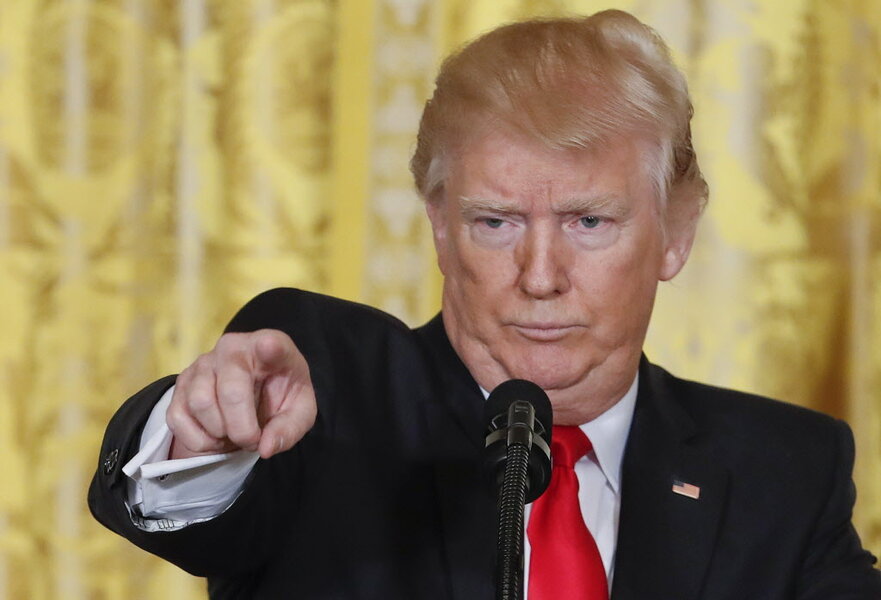How Trump is challenging the media to redefine its role
Loading...
| Washington
In a month’s worth of tweets from President Trump, perhaps none has packed more punch than his assertion that the “FAKE NEWS media ... is the enemy of the American People!”
The expression “enemy of the people” carries dark echoes of history, dating back to Roman times. The most brutal regimes of the 20th century invoked the phrase in sending millions to die.
For Mr. Trump, the use of such inflammatory language is clearly metaphorical. But in upping the rhetorical ante in his longstanding attacks on the Fourth Estate – specifically, as he said in his Friday tweet, the “failing” New York Times, NBC, ABC, CBS, and CNN – Trump is playing a game with potentially far-reaching consequences.
Public trust in media is at an all-time low, according to Gallup; reporters face a level of hostility from an administration not seen since President Nixon.
How the media work through this challenge will affect not only how this insurgent presidency is portrayed, but also how the American public sees the role of the press – as a biased meddler or an essential pillar of American democracy.
But it’s not all bad news for the media.
“In fact, contrary to the prevailing orthodoxy, Donald Trump is not the man who will kill the mainstream media. He is the man who could save it,” writes Amol Rajan, media editor at the BBC.
Paid subscriptions to news outlets have jumped during the Trump presidency. The New York Times reports a surge in digital subscriptions – 276,000 in the fourth quarter of 2016, the single best quarter since 2011, when its pay model launched.
Donations have spiked to the nonprofit investigative outfit ProPublica and to liberal standard-bearer Mother Jones. Online-only outlets have seen a surge in Web traffic, boosting ad revenue. CNN, perhaps the cable channel most reviled by Trump, reports 2016 was its best year for viewership.
How Trump has caused the media to overheat
Trump, the one-time reality TV star, clearly relishes performing for the cameras – including when sparring with reporters. He said as much in his pugilistic tour de force of a press conference last week.
“I sort of enjoy this back and forth, and I guess I have all my life,” Trump mused, before tossing in another dig at the press. “But I’ve never seen more dishonest media than, frankly, the political media.”
Before becoming president, Trump was famous for answering his own phone; back in the 1970s, ‘80s and ‘90s, he even posed at times as his own publicist.
As president, he has in some ways been more available to the media than his predecessor, frequently coming to the back of Air Force One to talk to the reporters traveling with him. At other times, he flouts convention by attending a public event without bringing the press “pool" – a rotating group of journalists who cover the president's daily activities.
Some of Trump’s media habits might be amusing if they didn’t involve the serious business of the presidency. Add to the mix his un-joking expressions of hatred toward the press, beginning early in his campaign, that raised the possibility of violence against reporters.
But even as he toys with journalists, his ultimate intent is clear: to use them as a foil by setting them up as “the opposition party.”
His declaration last Friday that certain major media outlets are “the enemy of the American people” was the logical conclusion of a long rhetorical escalation. Some media watchers have urged the press to focus on his actions, not his words. But with Trump, who recognizes the power of language, that’s not necessarily the best approach.
“Don't over-react or rage at every Tweet: good advice,” Jay Rosen, a journalism professor at New York University, tweeted Monday. “Pay attention to what he does, not what he says: dumb advice. Often, words are deeds.”
Standing up for media's role in a free society
For some in public life, Trump’s “enemy” tweet was a bridge too far. Sen. John McCain (R) of Arizona, who has emerged as one of Trump’s most vocal critics within the Republican Party, said on NBC’s “Meet the Press” that such talk is “how dictators get started.”
“In other words, a consolidation of power,” McCain elaborated. “When you look at history, the first thing that dictators do is shut down the press. And I'm not saying that President Trump is trying to be a dictator. I'm just saying we need to learn the lessons of history.”
Such a cautionary note may seem over the top. But across the media landscape, Trump’s attacks are being treated with dead seriousness. Conservative columnist Bret Stephens of The Wall Street Journal calls Trump’s approach to the media and to facts “darkly brilliant” – by effectively asserting that facts don’t matter.
How media can better tackle Trump's hostility
Reporters, too, are tackling Trump’s hostility head on. Some are trying to soften him up. “Just for the record, we don't hate you. I don't hate you,” CNN’s Jim Acosta, embroiled in a longstanding feud with Trump, told him at last Thursday’s press conference.
Others are standing by their journalistic brethren with the hashtag #NotTheEnemy, highlighting the important work reporters do in holding officials accountable, bringing injustice to light, and covering wars, at times losing their life.
Linguist George Lakoff appreciates journalists’ effort to defend themselves, but says they’re going about it in the wrong way. By putting the word “enemy” in the hashtag, they’re reinforcing the very concept that Trump is promoting – and thus, they are unwittingly helping Trump make his point.
It’s all about the “frame” – the way a subject is characterized, writes Professor Lakoff of the University of California, Berkeley, on his blog. “Avoid the language of the attacker,” he writes, “because it evokes their frame and helps make their case.”





